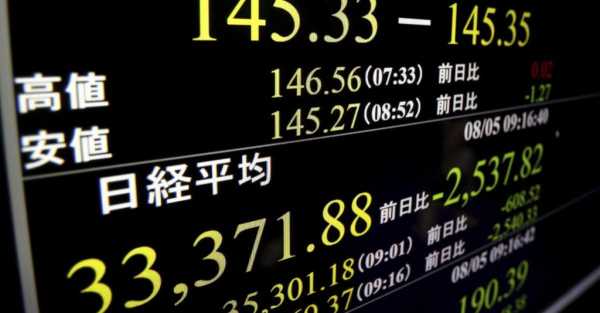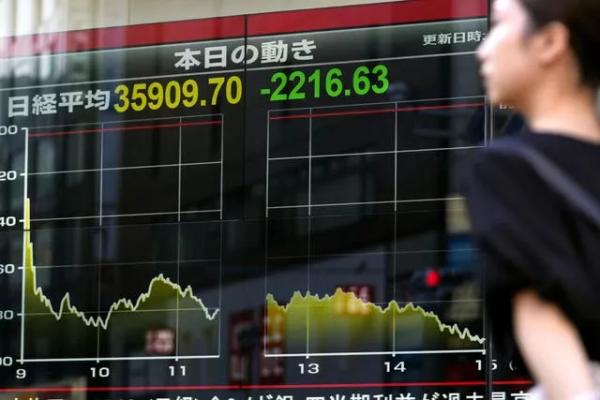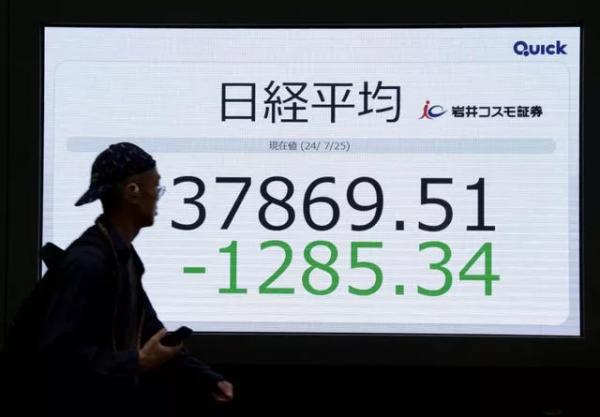
Japan’s benchmark Nikkei 225 stock index has plunged 12.4 per cent in the latest bout of sell-offs to shake world markets as investors fret over the state of the US economy.
The Nikkei closed down 4,451.28 points at 31,458.42 on Monday. The market’s broader TOPIX index fell 12.8 per cent as selling picked up in the afternoon.
A report that showed hiring by US employers slowed last month by much more than expected has convulsed financial markets, countering the euphoria that had taken the Nikkei to all-times highs of over 42,000 in recent weeks.
The Nikkei 225 dropped 5.8 per cent on Friday, making this its worst two-day decline ever.

Its worst single-day rout was a plunge of 3,836 points, or 14.9 per cent, on a day dubbed “Black Monday” in October 1987. At one point, the benchmark sank as much as 13.4 per cent on Monday.
Share prices have fallen in Tokyo since the Bank of Japan raised its benchmark interest rate on Wednesday. The Nikkei is now down 3.8 per cent from a year ago.
One factor driving the BoJ to raise rates was prolonged weakness in the Japanese yen, which has pushed inflation to above the central bank’s 2 per cent inflation target.
Early on Monday, the dollar was trading at 142.39 yen, down from 146.45 late on Friday and sharply below its level of more than 160 yen a few weeks ago.
The euro fell to 1.0896 dollars from 1.0923.
Shares surged to stratospheric heights earlier this year on frenzied buying of shares in companies expected to thrive thanks to advances in artificial intelligence.
The latest setback has hit markets heavily weighted toward computer chipmakers like Samsung Electronics and other technology shares: on Monday, South Korea’s Kospi plummeted 9.3 per cent as Samsung’s shares sank 11.6 per cent.
Taiwan’s Taiex also crumbled, losing 8.4 per cent as Taiwan Semiconductor Manufacturing Co, the world’s biggest chip maker, dropped 9.8 per cent.
Stocks tumbled around the world on Friday after weaker than expected employment data fuelled worries the US economy could be cracking under the weight of high interest rates meant to tame inflation.
Early on Monday, the future for the S&P 500 was 1.5 per cent lower and that for the Dow Jones Industrial Average was down 0.7 per cent.
Stephen Innes of SPI Asset Management, said: “To put it mildly, the spike in volatility-of-volatility is a spectacle that underlines just how jittery markets have become.

“The real question now looms: Can the typical market reflex to sell volatility or buy the market dip prevail over the deep-seated anxiety brought on by this sudden and sharp recession scare?”
The VIX, an index that measures how worried investors are about upcoming drops for the S&P 500, fell about 26 per cent as of early Monday. Bitcoin which recently had surged to nearly 70,000 dollars, was down 14 per cent at 54,155.00 dollars.
Oil prices were little changed. US benchmark crude oil gained nine cents to 73.61 dollars per barrel while Brent crude was flat at 76.81 dollars per barrel.
Yeap Jun Rong of IG said investors will be watching for data on the American services sector from the US Institute for Supply Management due later on Monday that may help determine if the sell-offs around the world are an overreaction.
Worries over weakness in the US economy and volatile markets have rippled around the world, even though the US economy is still growing, and a recession is far from a certainty.
Elsewhere in Asia, Hong Kong’s Hang Seng index lost 2.5 per cent to 16,519.78 and the S&P/ASX 200 in Australia declined 3.8 per cent to 7,637.40.
The Shanghai Composite index, which is somewhat insulated by capital controls from other world markets, edged higher but then gave way, losing 1.2 per cent to 2,870.34.
The S&P 500’s 1.8 per cent decline on Friday was its first back-to-back loss of at least 1 per cent since April. The Dow Jones Industrial Average dropped 1.5 per cent, and the Nasdaq composite fell 2.4 per cent.
Friday’s losses dragged the Nasdaq composite 10 per cent below its record set last month. That level of drop is what traders call a “correction”.
The rout began just a couple days after US stock indexes had jumped to their best day in months after US Federal Reserve Chair Jerome Powell gave the clearest indication yet that inflation has slowed enough for cuts to rates to begin in September.
Now, worries are rising the Fed may have kept its main interest rate at a two-decade high for too long, raising risks of a recession in the world’s largest economy.
A rate cut would make it easier for US households and companies to borrow money and boost the economy, but it could take months to a year for the full effects to filter through.
Tan Boon Heng of Mizuho Bank in Singapore said in a report: “Specifically, the scenario of higher unemployment constraining spending and further restraining hiring and incomes and economic activity leading to a recession is the feared scenario here.”
Sourse: breakingnews.ie






